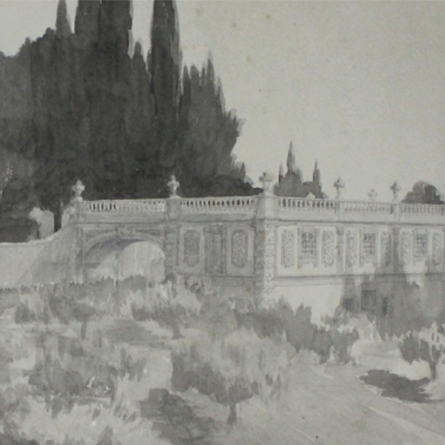Born in Uruguay into a wealthy British family Pinsent eventually moved to Europe where he became the architect that in the first half of the 20th century worked more than any other for the Anglo-Florentine community creating new gardens and transforming existing ones. According to a list drafted by Pinsent himself, he is the author of 23 gardens in Tuscany. Over the course of thirty years, he worked so intensely that it could be said that he reshaped two of the most famous hills of Florence: Fiesole and Arcetri. His projects are part of the revivalist trend establishing a dialogue between the Tuscan garden tradition and the Renaissance and Mannerist models. A practice that draws his work close to the principles of the Formal Garden as defined by his teacher Reginald Bloomfield’s, which he then made his own in Florence working side by side with the cosmopolitan milieu of Bernard Berenson and his wife Mary. The latter assured protection to the young architecture historian Geoffrey Scott, who then became a friend of Pinsent. Mrs Berenson eventually entrusted them with the realization of Villa I Tatti (1910-25). Berenson’s entourage gave Pinsent the possibility to enter the wealthy British and American elite in Florence, which included Charles Augustus Strong for whom he designed the garden of Villa Le Balze near Fiesole (1913-22). He also worked for Lady Sybil Cutting, a rich American widow who in 1918 married the troubled Scott, who commissioned the restoration of Villa Medici in Fiesole. But Pinsent’s most poignant work experience, besides I Tatti, was the Giardino della Foce, a masterpiece of landscape art commissioned by Iris Cutting Origo, daughter of Lady Sybil. In October 1938 after having retired to England, with a note of disenchantment he wrote to Mary Berenson:“
What I have offered is not congenial to the time, and what the times want is not congenial to me. Or perhaps it is all just simple laziness “. In 1945 he wrote to Berenson: “I am dead tired of Italy, but am irresistibly attracted to it […] I Tatti and La Foce were the scenes of my most poignant experiences”. After retiring in Switzerland, he remained inactive until his death in 1963.
Read also Iris Origo Look at the card of Villa I Tatti Look at the card of Villa La Foce



 Share on social
Share on social